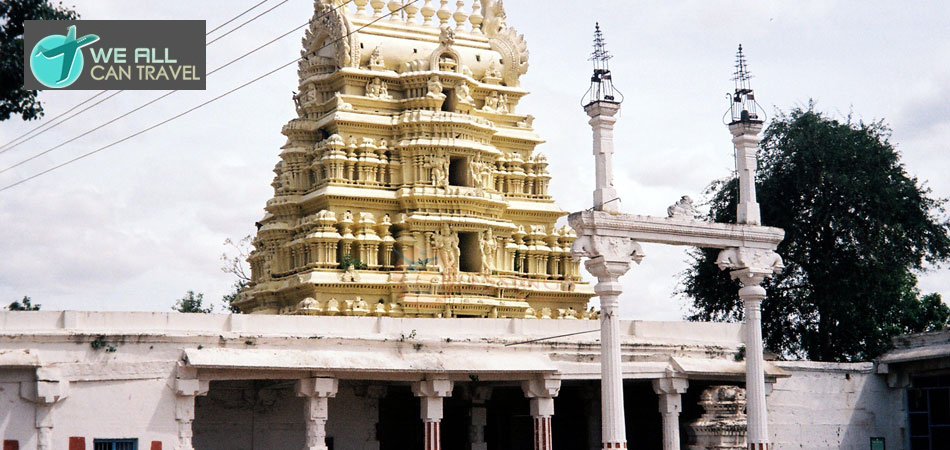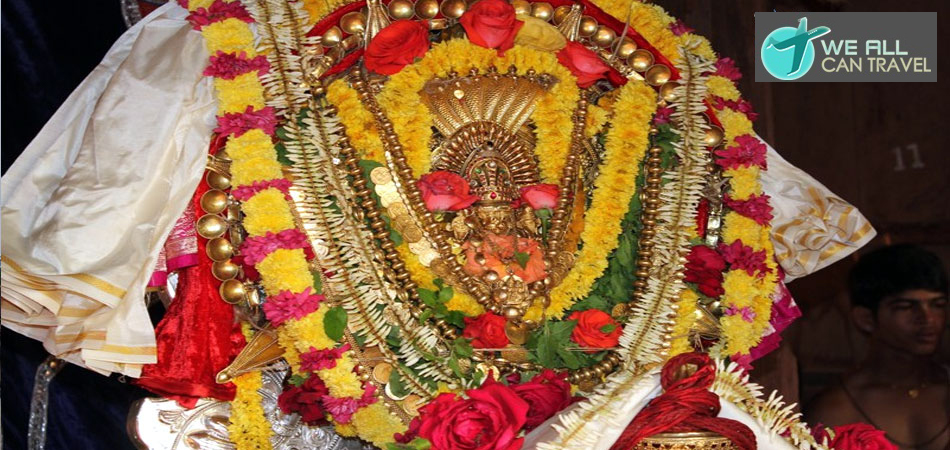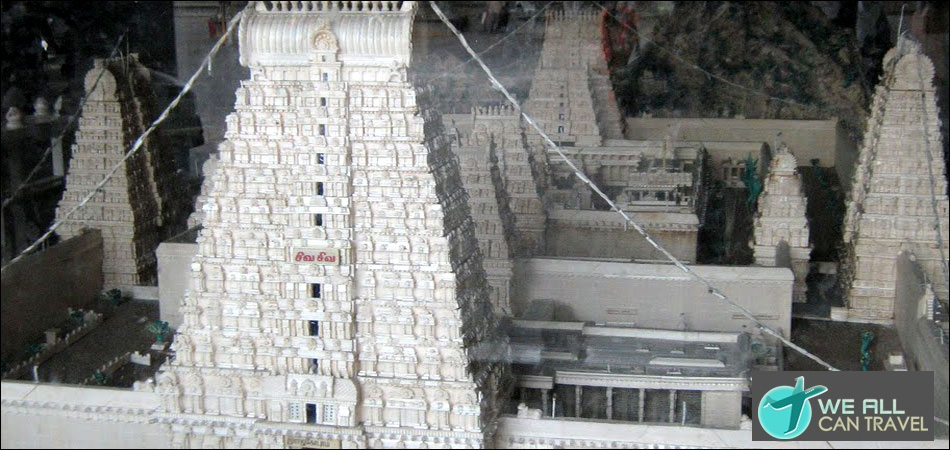Legend Of Temple
There is an interesting and popular legend about the discovery of the main idol of the Lord. The legend goes that the Lord revealed Himself in a dream, where he told the local people that his vigraha was left abandoned on the hill without worship and that the local people must trace it and reconsecrate it. Thereupon, all the local residents and the then Zamindar searched and discovered the idol at the foot of a tree. The worship was performed and the idol was installed a little higher at the present spot. There is in the Annavaram temple a famous and unique Yantra the like of which does not exist anywhere else in India. The yantra is based on the Tripad Vibhuti Narayana Upanishad which is a part of the Devarshi Sakha of the Adharva Veda. The shrine is constructed in two stories, the lower one containing the yantra and the upper one containing the vigrahas of the Lord. The garbha griha of the Lord has four entrances. In the center thereof, like a panavattam under the Sivalinga Tripeethas are construacted; and on the top of them, over the Meru portion the beejak-sharasamputi of the yantra is chiseled. At the apex thereof which forms the Bindu, a monolithic pillar is constructed and on the top of the pillar the image of the Lord is in the center, the image of Goddess is in the right and a Sivalinga is on the left. The idols are of exquisite grace and beauty and are encaged in gold kuvachams."
Hindus perform Sri Satyanarayana Vratham throughout India for weath, education, prosperity, off spring, relief from troubles and sickness and success in business. When it came to be known that Lord Satyanarayana had manifested Himself on the Ratnagiri hills at Annavaram with unique form combining trhe Trimurtis viz., Brahma, Vishnu and Siva and when the devoted Zamindars of Kirlampudi began to provide facilities for the pilgrims, the number of pilgrims from far and near swelled to hundreds and thousands. The average attendance daily is about two thousands now a-days. Though Ekadasi is considered to be very auspicious for the vratham, the individual devotees perform it even on other convenient days. The great popularity behind the vratham springs from the experiences narrated in stores and legends and also the faith gained by observances in daily life.
The important legend connected with this vratham was that once Sage Narada was very much distressed at the misery of marthyas(men in this world) and prayed Lord Vishnu to be informed of a way out for them. The lord then told him that Satyanarayana Vratham would relieve men of their troubles and would ensure worldly prosperity and salvation after death. He also narrated that a pious Brahmin of Banaras performed the vratham first. It was also described how king Ulkamukha of Bhadrasilanagaram, Emperor Tungadhwaja, and a community of Gollas in his kingdom, a Vaisya business man named Sadhuvu, and a poor woodcutter of Banaras has performed this vratham and were blessed by Lord Satyanarayanaswamy (Vishnu himself) with all they desired. The vratham has caught the fascination of millions owing to these stories within the understanding of scholars as well as laymen. All classes of people took to its performance and it is popular for its efficacy.
The origin of the vratham was narrated ad follows: once a highly educated and pious Brahmin who had no means of livelihood was wandering about from place to place being for food. Lord Vishnu had taken pity on his penury and appeared before him in the disguise of a Brahmin and advised him to perform the vratham of Lord Satyanarayanaswamy who is the incarnation of Lord Vishnu. He also told him the way in which the vratham was to be performed. The Brahmin thereupon got up early in the next morning and went out for alms. He could get funds enough for celebrating the vratham and did it as per the vratha directions given by Lord Vishnu. Consequenty, he was blessed by the Lord with prosperity and lived very happily with his family and attained salvation after death. A poor man who has been earning livelihood selling firewood from the forestschanced to go to that Brahmin's house for water to quench his thirst, while the Brahmin was engaged in performing Satyanarayana swamy Vratham. He waited till the end, quenched his thirst and enquired as to what the vratham was. The Brahmin told him in detail all about it and the poor man had decided to perform the vratham himelf and to spend the next day's earnings for the vratham. What he got the next day was enough for the vratham, which he performed with great devotion and became prosperous, happy and attained moksham. Another legend connected with Satyanarayana Vratham mentioned in Skandapuranam was as follows: A rich Vaisya couple Sadhuvu and Leelavathi begot a dauther Kalavathi as a result of the vow taken to perform Satyanarayana Vratham. They got her married with great pomp to a worthy young man. Sadhuvu and his son-in-law flourished in business and amassed great wealth by the grace of Lord Satyanarayanaswamy. But they forgot to perform Satyanarayana Vratham. They went to Ratnasanapuram on the seashore and commenced business there to add to their wealth. But they had lost the grace of the Lord, as they did not keep up their vow of performing vratham, amidst their prosperity. One night the treasury of the local king had been looted. Sadhuvu and his son-in-law were imprisoned on suspicion, even though they were really innocent. The mother and daughter became poor and sick and were forced to beg for food from house to house. While begging for food kalavathi chanced to witness Satyanarayana Vratham in a Brahmin's house and waited they're to receive the Lord's prasadam. She explained to her mother this incident as the reason for her being late in returning home. Leelavathi then remembered about the vratham and decided to perform it with no loss of time. By the Lord's grace she got all facilities to perform it The lord was pleased as a result of the vratham. Sadhuvu and his son-in-law were released from prison and all their confiscated wealth was returned to them by the king at the command of the Lord in a vision. They prayed to the Lord, performed the vratham, gave large amounts in charity and started back to their original place in a boat. Satyanarayanaswamy appeared in the ship as a sanyasi and asked Sadhuvu what he had on borad. Sadhuvu retorted that it was no concern of the sanyasi to know what in the boat was and ridiculed him by saying that there was some trash. 'Be it so', pronounced the Lord and all the wealth in the boat wsas reduced to trash. Sadhuvu began to weep and wail and as advised by his son-in-law he fell on the feet of the sanyasi and prayed for his pardon. The sanyasi reminded him that he had once again failed to perform His puja. Realising who the sanyasi was, Sadhuvu prayved Him), got back his wealth and safely reached the shores. He sent word to this wife and daughter that they were arriving soon at the house. Leelavathi was happy to receive the news and hastened her daughter to finish Satyanarayana puja so that they could hurry up to the seashore to receive their husbands. In the hurry up to the seashore to receiv their husbands. In the hurry both of them forgot to take the prasadam of Satyanarayanaswamy. The consequence was that the boat with the cargo and the son-in-law drowned in the sea. Sadhuvu was much grieved to see his only daughter preparing for sahagamana. He soon realized that Lord Satyanarayana alone could come to his relief and fervently prayed to him. The Lord revealed that the catastrophe was the result of Kalavathi not taking His prasadam in her hurry to go to her husband. Kalavathi rushed home, took the prasadam and hurried back to the seashore. There she saw her husband Ratnakara safe on the shore. She told him all about the Lord. He was so much impressed that he prayed to the Lord and with His blessings changed into Ratnagiri hill on which the Lord took His permanent abode. It is believed that river Pampa running by the hill is none other than kalavathi, who melted with ecstasy at the grace of the Lord and her husband's achievement and began to flow as Pampa River.
 >> Agasteeshwara Temple
>> Agasteeshwara Temple >> Anantha Padmanabhaswami Temple
>> Anantha Padmanabhaswami Temple >> Ananthasana Temple
>> Ananthasana Temple >> Annapoorneshwari Temple
>> Annapoorneshwari Temple >> Arunachaleshwar Temple
>> Arunachaleshwar Temple